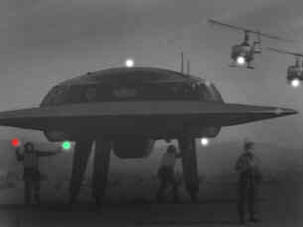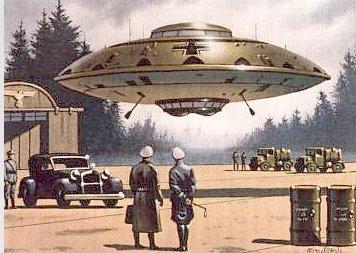 According to the lore, Germans landed on the Moon as early as 1942, using "exoatmospheric" rocket saucers. The Nazis had several models of rocket craft-- fifty and 150 feet in diameter, as well as a turbine-powered saucer 220 feet in diameter that was intended for interplanetary travel. The largest craft was had ten stories of crew compartments. It was about 130 feet high.
According to the lore, Germans landed on the Moon as early as 1942, using "exoatmospheric" rocket saucers. The Nazis had several models of rocket craft-- fifty and 150 feet in diameter, as well as a turbine-powered saucer 220 feet in diameter that was intended for interplanetary travel. The largest craft was had ten stories of crew compartments. It was about 130 feet high.Another part of the lore tells us that "beyond the shadow of a doubt there is atmosphere, water and vegetation on the Moon, and man does not need a space suit to walk on the Moon. A pair of jeans, a pullover and sneakers are just about enough. "
The story continues that everything NASA has told the world about the moon is part of a deliberate disinformation campaign to keep the moon club exclusive. Obviously, these physical conditions make it a snap to build a Moonbase. And guess what? Naturally, there are a few on the moon!

Shortly after landing, the Germans hopped out and began tunneling under the surface. By war's end, a small Nazi research base was established on the moon.
By 1944, the Germans had people, materiel and the first robots at the lunar construction site. When Russians and Americans secretly landed on a joint mission with their own saucers in the early fifties, they spent the first night as guests of the Nazis in the underground base.
In the sixties a massive Russian - American base had been completed. The rumor says the Moon now has a population of 40,000 people. After the end of the war in May 1945, the Germans continued their space effort.
According to one Renato Vesco, Germany was sharing a great deal of the advances in weaponry with their allies, the Italians, during the war. At the Fiat experimental facility at lake La Garda, a facility that fittingly bore the name of air martial Hermann Goering, the Italians tested advanced weapons, rockets and airplanes, created in Germany. The Japanese also received the benefits of the Nazi technology.
In July of 1945, two and a half months after the war ended in Germany, a huge German transport submarine brought to Japan the latest German invention--two spherical, wingless flying devices. The Japanese put the machines together, following the German instructions, and created a ball shaped flying device without wings or propellers. But, nobody knew how it worked! Fuel was added, the start button of this unmanned machine was pressed and it disappeared with a roar and flames without a in the sky. The team never saw it again. The engineers were so freaked out, they dynamited the second prototype and chose to forget the whole incident.

According to the authors of the underground German documentary movie from the Thule society, a very advanced, 220 foot diameter "dreadnought" was chosen for a trip to Mars. A volunteer suicide crew of Germans and Japanese was chosen, because everybody knew that this journey was a one-way trip with no return. The large intensity of the electro-magnetogravitic fields and the inferior quality of the metal alloys used then for the structural elements of the drive, was causing the metal to fatigue and get very brittle after only few months of work. The flight to Mars departed from Germany one month before Patton's and Montgomery's armies overran Berlin. Hitler must have decided to go down with the ship, having passed up the chance to head into the heavens.
This saucer had a crew in the hundreds, because of the low level of automation and electronic controls inside the saucer. Most of the systems were operated like those on a U-boat of that time (a lot of manual knobs and handles). Because the structurally weakened "tachyon drives" were not working with full power and were not functional all the time, the trip to Mars took eight months. An initial short trust towards Mars was probably used to break the gravitational field close to Earth. After that, the craft was coasted for 8 months in an elliptical orbit to Mars with its power turned off. Later trips to Mars by the joint Soviet - American craft in 1952 and a Vatican craft (!!!) reached Mars in only 2 - 3 days, in 1956, because their drives were working and more robust.
No one seems to know how the Germans were able to regenerate air for the hundreds of crewmen inside the craft for eight months. Quite probably they were using the sort of advanced life support systems that had been developed for submarines.
The saucer landed hard on Mars in January, 1946. They sent a radio message indicating they had landed, and were now stranded. The story seems to end there.
---o0o---
No comments:
Post a Comment